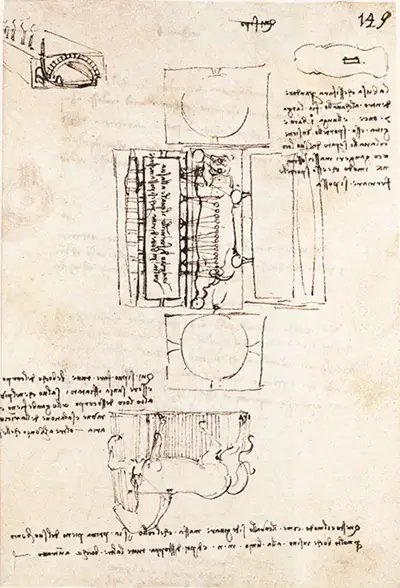In it, he makes detailed plans for a monument which is generally known to modern art historians as the Sforza Horse. The manuscript pages sit alongside a number of other sketching and drawings and even a beeswax model that da Vinci made in preparation for the monument's construction.
Unfortunately, despite over 10 years of planning and design on the part of Da Vinci and others the monument was never actually built.
An invading French army destroyed most of the advanced plans for its construction during an invasion in the year 1499. Da Vinci later began plans for an even grander monument featuring a horse with a rider on its back, it too would be left unbuilt in his lifetime.
The piece is generally described as a manuscript but plans probably be a more accurate word. The page features notes and a number of relatively technical drawings.
Da Vinci got into a much greater level of technical detail with regards to the Sforza Monument than he did with many of his later artistic plans. Another surviving page shows detailed plans for the molds that would have been used to cast the enormous head of the horse.
What is missing from this page is any sense of the scale the statue would have had once it was complete. Other surviving manuscripts and plans however, make it clear that the statue would have been truly enormous. Da Vinci's aim was to create the largest equestrian statue that had ever been constructed.
The level of detail which Da Vinci went into in the manuscript and other Sforza Horse related documents shows just how seriously he took the project.
Many of the other sketches created during his lifetime lack the detail that would have been required to turn the plans into physical objects.
In the case of the Sforza Monument however, not only are there detailed plans on how the horse would have looked once it had been erected, there is also a detailed scheme proposing how the work would have been carried out.
Da Vinci has considered many of the practical barriers that he would have come up against during construction and proposed workable solutions. In this case, it seems that it may simply have been bad timing with regards to an invading army that prevented work on the Sforza Horse from being carried out.
The Manuscript Page on the Sfotza Monument is held, along with a number of other articles related to the Sforza Horse, by Spain's National Library, the Biblioteca Nacional in Madrid.
It's not on regular public display but is available for inspection by art historians and other people with a genuine professional need for seeing it. The condition of the manuscript makes more regular public display a near impossibility.


